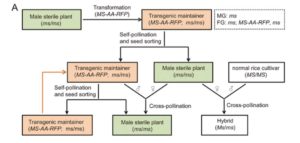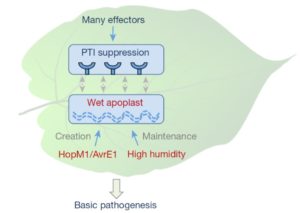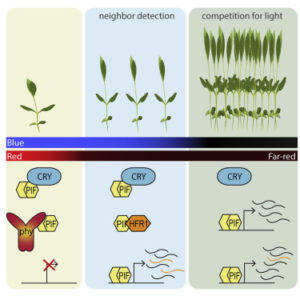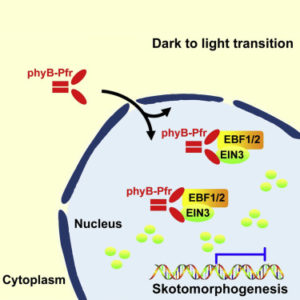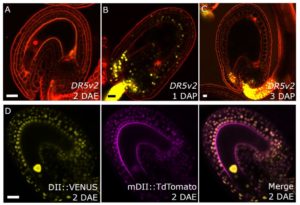Videos are excellent ways to communicate about plant science. They can stimulate curiosity, explain a complicated idea, or make the invisible visible. Here is a curated list of some of our favorite short plant science videos.
Crash Course Biology: Plant Cells (10 min), Photosynthesis (13 min), The Sex Lives of Nonvascular Plants (10 min), Vascular Plants = Winning (12 min), The Plants and the Bees: Plant Reproduction (10 min)
It’s OK to Be Smart: Which Came First – Flowers or Bees? (5 min), Do Plants Think? (6 min), Your Salad is Trying to Kill you (6 min), How Many Trees Are There? (6 min)
Veritasium: The Most Amazing Thing About Trees (7 min), Where Do Trees Get Their Mass From? (4 min), Inside the Svalbard Seed Vault (9 min)
Minute Earth: Why (nutrient) poor places are more diverse (3 min), The Secret Social Life of Plants (2 min), How do Trees Survive Winter? (3 min), Why are leaves green? (Part 1 and Part 2) (2 min each), The Real Reason Leaves Change Color In the Fall (2 min), Which Came First – The Rain or the Rainforest? (3 min), Who Are Flowers Trying To Seduce? (3 min), Orchids: The Masters Of Lying, Cheating & Stealing (4 min)
BBSRC: How plant science is rewriting our future stories (3 min), How plants crawled onto the sea (2 min), Plant power: Plants versus explosives (2 min), Plant power: Plants versus petrol (2 min), Plant power: Plants versus fish (2 min), Plant power: Plants versus floods (2 min), Plant power: Plants versus obesity (2 min), The foods of the future (2 min)
PBS NewsHour: To combat climate change, these scientists are turning CO2 into rock (2016, 9 min), The end of bananas as we know them? (2016, 5 min), Restoring San Francisco Bay’s wetlands one native plant at a time (2016, 6 min), The secret life of plants — and ‘Lab Girl’ author Hope Jahren, (2016, 6 min), Medical marijuana research comes out of the shadows (2016, 9 min), How to grow an Ebola vaccine with a tobacco plant (2015, 6 min), California’s water-starved sequoias show signs of stress (2015, 6 min), Why growing lettuce in New York City is a growing business (2015, 8 min), Is it nuts to grow almonds during a drought? (2015, 8 min), Why does almost half of America’s food go to waste? (2015, 9 min), Italian olive trees are withering from this deadly bacteria (2015, 7 min), The phytoplankton that brought Earth to life (2014, 5 min), Paradise found: A history of pineapple, sugar and seeds in Hawaii (2013, 3 min), Balancing Costa Rica’s Farming With Preservation with Nature (2013, 9 min), California Works to Rescue Franciscan Manzanita Plant from Extinction (2011, 7 min)
Piffle: What is a GMO? (5 min)
Washington University St. Louis: Why don’t plants grow upside down? (3 min)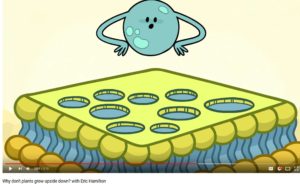
HHMI Interactive: Popped Secret: The Mysterious Origin of Corn (18 min)
SAPS: Animation – Transport of water and sugar in plants (4 min)
BBC Video library – Plants (several clips of various lengths)
Duc Phan Tran, University of Halle: Xanthomonas (computer animation of infection process) (6 min)
IntoBiology: From the cell to the planet in 90 seconds (1.5 min)
Borlaug Global Rust Initiative: The life cycle of wheat stem rust (7 min)
CIMMYT: Why invest in wheat research (5 min)
Royal Botanic Garden Edinburgh: Moving forward from ash dieback (3 min)
Kew Gardens: The forgotten home of coffee (6 min)
BBC Unplugged: Exploding seeds, slo mo (5 min)
Monash University: Feeding the future featuring Ros Gleadow (4 min)
University of Glasgow: Plant Science Investigation (PSI) (CSI spoof) (7 min)
Science magazine: Forest health in a changing world (2.5 min)
TED-Ed: How a single-celled organism almost wiped out life on Earth (Anusuya Willis, 4 min), Can plants talk to each other? (Richard Karban, 5 min), The simple story of photosynthesis and food (Amanda Ooten, 4 min)
Encyclopedia of Life: Invasive Species, stories of biodiversity on the move (7 min)
American Museum of Natural History: Green grow the salamanders (6.5 min)
Ramesh Boonratana: Mangrove forests and vivipary (2.5 min)
International Plant Nutrition Institute: The Role of 4R Nutrient Stewardship in Reducing Greenhouse Gas Emission (5 min)
Biolapse: Carnivora Gardinum (carnivorous plant timelapse) (4 min)
Collections and channels
Chris Martine’s Plants are Cool too series – several videos (7 – 15 min)
Claire Hopkins Brilliant Botany video series – several videos (most < 5 min)
Many time-lapse videos can be found at Roger Hangarter’s Plants in Motion site (most < 3 min)
A now-closed plant video competition ChloroFilms features some great contributed videos
Food and Agriculture Organization (FAO): Dozens of videos in many languages – including Year of Pulses videos
IFAD: International Fund for Agricultural Development. Videos about farming challenges around the world
Smithsonian Channel: Plants
CABI videos: Many videos about invasive species and agronomic practices
AgriumInc: Fertilizer 101 (8 videos about fertilizer)
Video featuring songs
The Cambridge iGEM team: The Gibson asssembly song (4 min)
University of California Irvine: Chemists Know (Parody of Let it Go from Frozen) (4 min)
Musical Cells: Power Pack: The mitochondria rock song (4 min)
Biology Fortified Inc: Play it hard – Norman Borlaug 100 year tribute (3 min)
Kamoun Lab: Fifi the oomycete (2 min) and You can call me Al (for Albugo) (4 min)
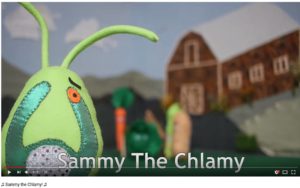
Jonikas Lab ♫ Scientists Are Saving The World With Puppets And Algae ♫ (3.5 min)
HarvestPlus: Better nutrition from high-iron beans (5 min)
Kris Holmes: La Bloomba (2.5 min)
Science Rap Academy: They grow (2 min)
ZhengLabProductions: Bad Project (Lady Gaga Parody) (5 min)
Massague Lab: Don’t Stop Pipetting (5 min)
CohenfordMU: The Lab Song (Bruno Mars Parody) (3.5 min)
Weigelworld: Shake it off (parody) (4 min)
Weigel Style (Gangnam Style Parody) (5 min)
And many more science-y song parodies can be found on YouTube….



